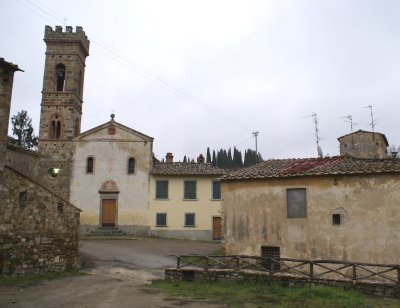In Chianti (3)
Posted on 15 January 2009
Our stay in Chianti is slowly drawing to an end. But it’s been immensely rewarding. Today we spent an entire afternoon at Isole e Olena.
Paolo de Marchi, owner of Isole e Olena.
Paolo De Marchi’s family comes from northern Piedmont, the land of Nebbiolo, so it is no wonder he brought with him quite a different wine sensitivity. His Sangiovese is among the palest-coloured, crispest, and most elegant in Chianti. We spent a lot of time in the vineyards, talking about the impressive vineyard replanting and clonal selection work that has been done here since 1976, when Paolo joined the estate. Replanting was necessary because all the vineyards planted after the massive migration were of insufficient quality. As heroic as the effort was for the owners in the 1960s to build their operations from scratch, vineyards were planted with vigorous high-yielding clones, at low density so as to allow mechanisation, etc. It took a good decade to experiment and select the best old genotypes of Sangiovese, and another to re-establish them in the vineyards. Meanwhile, white grapes were eliminated, French varieties introduced, plantings densified, cellars modernised. Modern Chianti is only now coming out of this painful adolescence.

The hamlet of Olena.
We tasted very good Chardonnay, Syrah and Cabernet Sauvignon but the Sangiovese wines shone above all else. I really like the Isole e Olena Chianti Classico for how unextracted and ‘unambitious’ it is. This is a wine not about power or concentration but zest and invigoration: precisely what Chianti should be in my book. Not a winemaker’s Chianti – even less so than Fèlsina’s – but a restaurant-goer’s. Buy as much of the 2006 as you can find. For Isole’s top Sangiovese, Cepparello (still bottled as an IGT, not a Chianti), we tasted the 2005 and 2006 (the latter unreleased). Back in October, the 2005 was tight as a fist, like a crouching tiger in the dark jungle of which you only see the glowing eyes. Now it has opened into a gem of floral, cherry-scented juiciness.
Sunset over Isole.
This long visit ended with a delightful dinner at the Michelin-1* restaurant Albergaccio in Castellina. The rather traditional food there paired well with older wines from Isole. Cepparello 1995 showed a little inert but the 1991, from an underrated vintage, was excellent, fresh and pitched. There was also a light but elegant Chianti 1988 and a more complex, satisfying 1982 Riserva, but the surprise of the night was the 1995 Chardonnay, saline and stony like a good Chablis!

